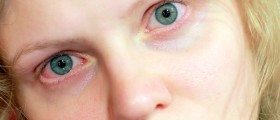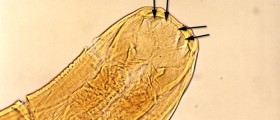
Cats, similarly to humans, may develop eye infections caused by different infective agents including bacteria, viruses and fungi. Each and every case of feline eye infection requires prompt examination and adequate treatment.
Eye infections are actually quite a common health issue these animals face with. The infection is associated with recent eye injuries or trauma or occurs alone without any previous loss of eye's integrity. The affected eyes are inflamed, red, there is discharge of different appearance and the cat is in pain.Feline Eye Infections Causes
Conjunctivitis (pink eye) is one of the most commonly reported eye infections in cats. This medical condition also affects dogs most of the time. Inflammation of the conjunctive develops as consequence of exposure to certain allergens or can be bacterial or viral in origin. Cats are, for instance, more susceptible to chlamydia and this infective agent is frequently isolated after taking swabs of the eye discharge. Apart from bacterial infections, cats are also prone to certain viral eye infections. These are most commonly associated with calicivirus and feline herpes virus 1. Finally, fungal infections are not frequently reported in cats. They only occur if the immune system of the animal is weakened.
Feline Eye Infections Symptoms and Signs
The infection can be easily recognized. There is noticeable inflammation of the conjunctiva and sometimes cornea. The inner surface of the eye is red. The cat loses the ability to blink and there is discharge coming from the eye. Squinting, excessive tearing, sneezing and nasal congestion are several more characteristics of the disease. Discharge is blamed for eyelids sticking together while itching drives the animals to rub their eyes frequently. In more severe cases there may be ulcers on the cornea and progression of the infection to the entire eyeball leads to eye protrusion.Feline Eye Infections Treatment Options
Treatment for cat eye infections depends on the microorganisms blamed for the infection as well the severity of inflammation.
Bacteria are easily eradicated with antibiotics applied in a form of eye drops or eye ointments. In case bacterial infection is complex and affects deeper tissues of the eye, the cat will have to take oral antibiotics along with topical antibiotic treatment of the eye.
Antiviral medications are essential for treatment of viral infections and fungi are treated with antifungal drugs.
It is essential to act promptly and take the pet to veterinarian as soon as possible. Left untreated, feline eye infections may cause corneal ulcerations and even more severe complications which all can lead to loss of vision.


_f_280x120.jpg)













Your thoughts on this
Loading...